Push notifications for ecommerce brands have emerged as a powerful tool to engage customers directly on their devices, fostering personalized interactions and driving revenue growth.
A survey reveals that e-commerce businesses lead the way in push notification usage, accounting for approximately 22.03% of the total share, making them the top industry in utilizing this communication tool.
In this comprehensive guide, we will explore the transformative role of push notifications for ecommerce businesses, shedding light on their numerous benefits, effective strategies, and how an ecommerce marketing platform can aid in the growth of your ecommerce business.
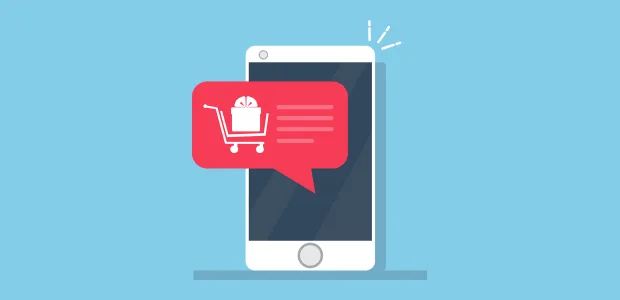
What are Push Notifications?
Push notifications are short, clickable messages sent directly to users’ devices, such as smartphones, tablets, or desktops.
They can be delivered via mobile apps or mobile web- browsers, providing businesses with a direct communication channel to reach their target audience.
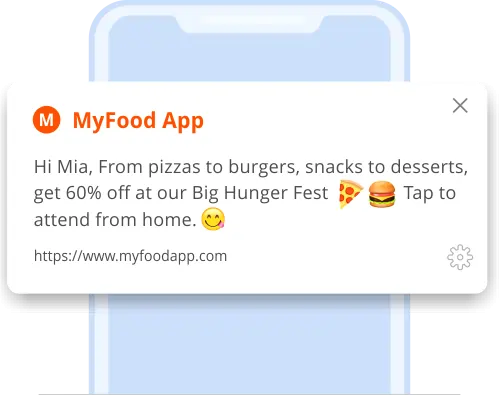
Push notifications have become an indispensable marketing tool. They allow businesses to send timely updates, flash sales, promotions, and personalized offers to their customers, boosting engagement and driving conversions.
Also Read: https://netcorecloud.com/blog/push-notifications-guide
Benefits of Ecommerce Push Notifications
1. Real-Time Engagement with Customers
Push notifications enable ecommerce businesses to communicate with their customers in real time. Whether it’s announcing a flash sale, introducing a new product line, or sharing time-sensitive offers, push notifications allow for instant updates.
The immediacy of these notifications creates a sense of urgency, prompting users to take immediate action, resulting in increased click-through rates and conversion rates.
2. Increased Conversion Rates
One of the most significant advantages of ecommerce push notifications is their ability to boost conversion rates. By delivering targeted and relevant content, ecommerce businesses can guide users through the customer journey, nudging them toward making a purchase.
Personalized product recommendations, tailored offers, and reminders about abandoned carts are just some of the tactics that can lead to higher engagement and more conversions.
4. Re-engage Customers from Abandoned Cart Recovery
One of the most significant challenges for ecommerce businesses is cart abandonment. Push notifications offer an effective solution for retargeting customers who have abandoned their shopping carts. Sending personalized reminders and exclusive discounts can entice users back to the checkout page, recovering lost revenue.
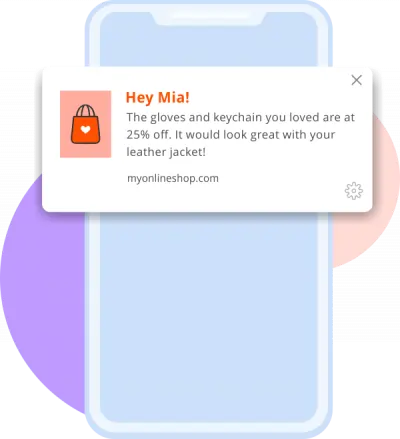
5. Sending Promotions and Exclusive Offers
Push notifications serve as a direct channel for delivering exclusive promotions and time-sensitive offers. Making customers feel valued can foster brand loyalty and repeat purchases. These promotions can range from early access to sales to special offers available only to push notification subscribers.
6. Customer Loyalty and Retention
Nurturing existing customers is essential for the long-term success of any ecommerce business. Push notifications provide a valuable avenue for engaging with loyal customers, strengthening brand loyalty, and enhancing customer retention. Consistently providing value and personalized experiences through push notifications reinforces the bond between the brand and its customers.
Here’s the story of how Nykaa achieved a 50% increase in revenue with the help of push notifications.
Ecommerce Push Notification Strategies
1. Understanding Customer Behavior and Preferences
The foundation of a successful push notification marketing strategy lies in understanding customer behavior and preferences. Analyzing data on past interactions, purchase history, and user preferences gives valuable insights into what drives user engagement.
This data-driven approach allows for more informed decisions in crafting relevant and targeted push notification campaigns.
2. Setting Clear Objectives and Goals
To maximize the impact of ecommerce push notifications, businesses must define clear objectives and goals. Whether the aim is to increase sales, drive website traffic, or boost customer engagement, having specific targets in mind helps in measuring success and refining strategies as needed.
3. Timing and Frequency of Push Notifications
Getting the timing and frequency of push notifications right is crucial. Bombarding users with too many notifications can annoy users and increase opt-out rates. On the other hand, being too infrequent might result in missed opportunities to engage users. Striking the right balance involves understanding the preferences of individual users and tailoring the delivery of push notifications accordingly.
4. A/B Testing for Optimization
Continuously optimizing push notification campaigns is vital for success. Constantly doing A/B tests for ecommerce push notifications is crucial to identifying the ideal format. This method allows businesses to identify the most effective messaging, timing, and call-to-action elements, refining their approach over time.
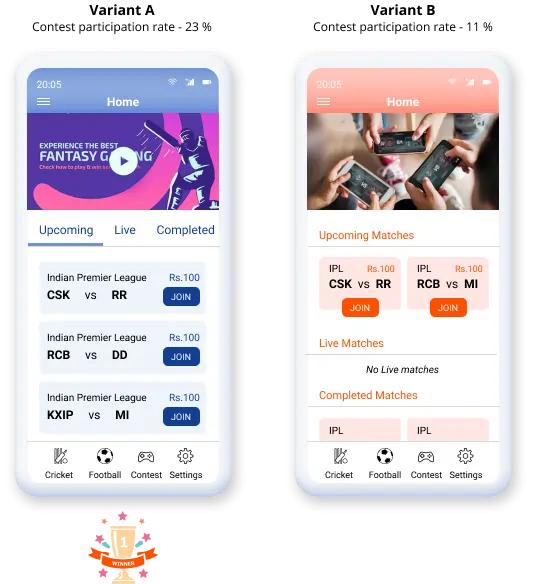
5. Utilizing Rich Media and Interactive Content
Visual appeal plays a crucial role in capturing users’ attention and driving engagement. Ecommerce businesses can leverage push notifications to include rich media elements such as images, videos, and GIFs. Moreover, interactive content, such as quizzes or polls, fosters user participation and interaction, making push notifications more engaging and memorable.
Segmenting Your Audience for Targeted Messaging
1. Demographic Segmentation
Demographic segmentation involves categorizing customers based on characteristics such as age, gender, location, language, and occupation. Tailoring push notification content to specific demographic segments ensures that users receive content that resonates with their unique preferences and cultural context.
2. Behavioral Segmentation
Behavioral segmentation involves grouping customers based on their past behavior and interactions with the ecommerce platform. Factors such as browsing history, purchase frequency, and preferences for specific product categories are considered. By understanding user behavior, businesses can deliver targeted and relevant push notifications, increasing the chances of engagement.
3. Geographic Segmentation
Geographic segmentation allows businesses to target users based on their location. This approach is particularly useful for ecommerce companies with physical store locations, as they can promote in-store events, localized offers, or relevant products based on regional preferences.
4. Purchase History and Preferences
Leveraging data on past purchases and individual preferences allows ecommerce businesses to create hyper-personalized push notifications. By offering relevant product recommendations and targeted cross-selling or upselling offers, businesses can enhance the overall shopping experience, leading to increased customer satisfaction and loyalty.
Personalization: The Key to Engaging Push Notifications for Ecommerce Industry
To maximize their impact, personalization has become the key differentiator. Tailoring push notifications to individual user preferences, behaviors, and purchase history enhances relevance and resonates with customers on a deeper level.
1. Dynamic Content and Product Recommendations
Dynamic content in push notifications involves updating the message content in real time based on user actions or recent interactions.
Ecommerce businesses can utilize this feature to provide personalized product recommendations based on users’ browsing or purchase history. By offering products aligned with individual interests, businesses can entice users to click through and explore further.
2. Personalized Offers and Discounts
Addressing customers by name and tailoring offers based on their purchase history adds a personal touch to push notifications. Customers are more likely to respond positively to personalized messages that cater to their specific needs and preferences. Offering exclusive discounts or promotions can further incentivize customers to take action, such as making a purchase or visiting the website.
3. Utilizing User Data and Preferences
Push notifications are most effective when businesses leverage user data and preferences to create relevant and engaging content. Analyzing past interactions, purchase history, and browsing behavior allows businesses to anticipate user needs and deliver content that aligns with their interests. For example, a fashion retailer can send push notifications featuring new collections to customers who have previously shown an interest in similar items.
Opt-In Strategies and Building Trust
Mobile push notifications follow a more complex opt-in process compared to email and SMS marketing, as different phone providers offer varying ways for users to opt in, impacting the opt-in rates for different devices.
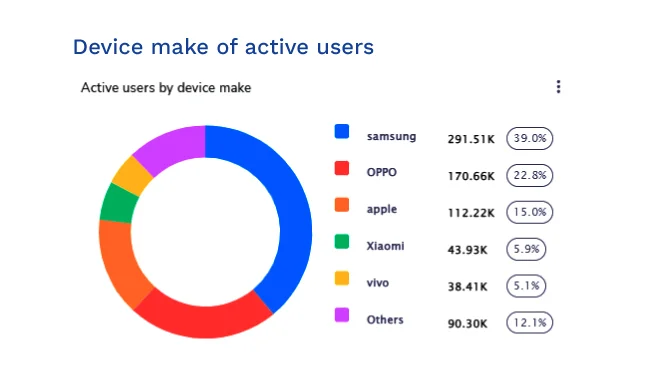
1. Transparent Privacy Policies
Building trust with customers is crucial when it comes to obtaining opt-ins for push notifications.
Ecommerce businesses should be transparent about their data usage and privacy policies, assuring users that their personal information will be handled responsibly and securely.
2. Value Propositions for Opt-In
To encourage users to subscribe to push notifications, businesses must communicate the value and benefits of doing so. Clear and compelling value propositions, such as exclusive access to limited-time offers or personalized product recommendations, can entice users to opt-in willingly.
3. Incentives for Subscribing to Push Notifications
Offering incentives to users who opt-in to use push notifications can be an effective way to grow the subscriber base.
Ecommerce businesses can provide discounts, free shipping, or exclusive access to members-only sales as rewards for subscribing to push notifications. These incentives create a win-win situation where customers receive added value, and businesses gain direct communication with interested users.
4. Timing and Placement of Opt-In Requests
Strategically timing opt-in requests is crucial to increasing their success rate. For example, requesting opt-ins after a positive user experience, such as completing a purchase or signing up for an account, can increase the likelihood of users agreeing to receive push notifications. Additionally, businesses should ensure that opt-in requests are easily accessible and unobtrusive, such as through a pop-up or a dedicated section within the app or website.
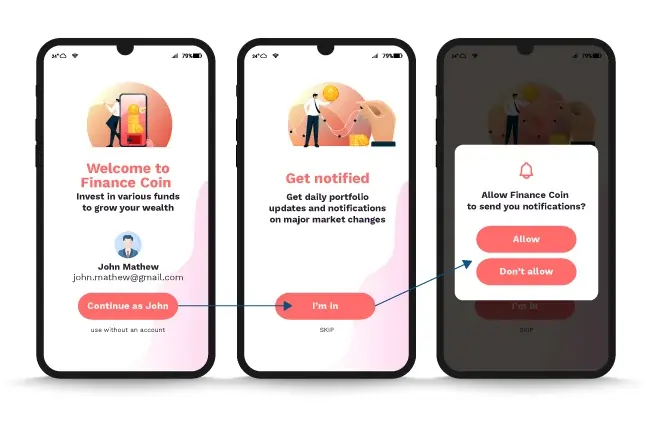
Apple iOS devices require an active opt-in process, meaning app users must agree to receive mobile push notifications before brands can send them. On the other hand, Android devices automatically opt users in to receive push notifications upon app download, and users need to manually opt out to stop receiving messages.
Android’s approach provides a wider audience of push-enabled users by default compared to iOS. However, Apple’s process ensures that your subscriber list consists only of engaged and willing users, whereas Android’s users may not be as eager to receive notifications. Failing to offer an easy opt-out option can lead to users being frustrated by unwanted or excessive notifications, potentially resulting in them disabling messages or uninstalling the app.
Tips for Writing Compelling Push Notification Copy
Crafting effective push notifications requires a strategic approach, combining concise messaging, personalized content, and compelling calls-to-action (CTAs). Here are a few things to keep in mind while writing your push notifications copy.
1. Concise and Action-Oriented Language
The limited character count in push notifications demands concise and action-oriented language. Captivating users’ attention with a clear and succinct message is essential to driving click-through rates. Effective copy should convey the essence of the message without unnecessary details.
2. Creating a Sense of Urgency
Urgency is a powerful psychological trigger that can prompt users to take immediate action. By using phrases like “Limited time offer” or “Ending soon,” businesses can create a sense of urgency or FOMO, encouraging users to click through before they miss out on an opportunity.
3. Emphasizing the Value Proposition
The value proposition of the push notification should be front and center. Businesses using web push notifications must clearly communicate the benefits users will receive by clicking on the notification, such as access to exclusive deals or personalized recommendations.
4. Call-to-Action that Encourages Click-Through
A strong and compelling call-to-action (CTA) is vital for driving engagement. Using action verbs like “Shop Now,” “Discover More,” or “Claim Your Discount” motivates users to click through to the desired action. The CTA should align with the content and be straightforward in guiding users to the next step.
Avoiding Push Notification Pitfalls – What You Should Avoid
1. Overwhelming Users with Notifications
Sending an excessive number of push notifications can lead to user fatigue and irritation. Businesses must strike a balance between staying engaged with users and avoiding overwhelming them with too many push notifications too. Analyzing engagement metrics and user feedback can help determine the optimal frequency for sending push notifications.
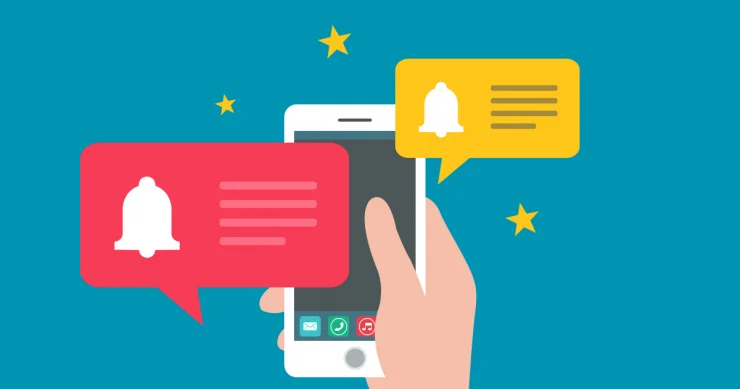
2. Irrelevant and Generic Messages
Sending generic messages that do not resonate with users’ interests can lead to disengagement and opt-outs. Each push notification should be tailored to specific segments of the audience to ensure relevance and avoid generic content.
3. Ignoring User Preferences and Opt-Outs
Respecting users’ preferences is critical for maintaining a positive relationship with the audience. Ignoring opt-out requests or continuing to send irrelevant content can harm brand trust and reputation.
Businesses should honor user preferences promptly and ensure smooth opt-out processes. While it may be counter-intuitive to give an opt-out option, the good part is that it can prevent customers from giving bad reviews or raising complaints about your business.
4. Lack of Clear Value in Notifications
Push notifications must offer clear value to the recipient. Whether it’s a discount on a favorite item, personalized product recommendations, or early access to a sale, the most push notification messages should present a compelling reason for users to engage with the content.
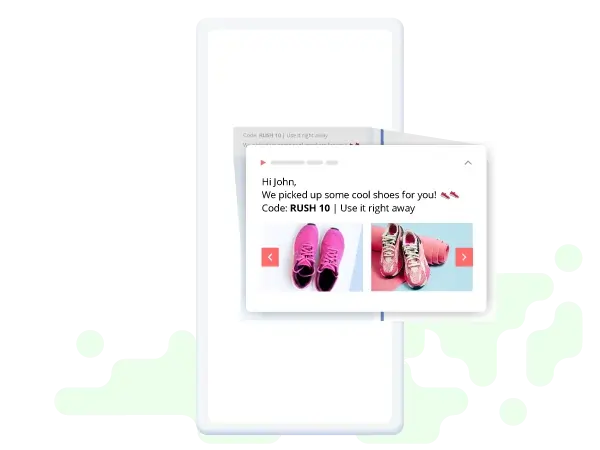
Measuring the Impact of Push Notifications – Analytics and Tracking
As businesses harness the potential of push notifications to connect with their audience, understanding their impact becomes crucial for optimizing marketing strategies and enhancing customer experiences. It’s important delve into the key metrics and performance indicators that businesses should consider to evaluate the success of their push notification campaigns.
1. Measuring Click-Through Rates
Click-through rates (CTR) are a fundamental metric for assessing the effectiveness of push notifications. By tracking the percentage of users who clicked on the notification compared to the total number of push notifications work were sent, businesses can gauge how well their content and messaging resonate with the audience.
2. Analyzing Conversion and Purchase Rates
Linking push notifications to specific conversions or purchases allows businesses to measure the direct impact of push notifications on revenue generation. Tracking the conversion rate of users who clicked on the push notification message and completed the desired action provides valuable insights into the overall effectiveness of push notification campaigns.
3. Tracking Opt-Out and Unsubscribe Rates
Monitoring opt-out and unsubscribe rates helps businesses gauge user satisfaction with push notifications. If opt-out rates are unusually high, it may indicate that the messaging or frequency of push notifications needs to be adjusted to better align with user preferences.
4. Assessing the Impact on Customer Lifetime Value
Analyzing how push notifications impact customer lifetime value (CLV) provides a holistic view of their overall value to the business. By evaluating how push notification subscribers compare to non-subscribers in terms of loyalty, average order value, and retention rate, businesses can assess the long-term benefits of maintaining an engaged subscriber base.
What are Some of the Best Practices to Improve Push Notification Strategy?
1. Embrace Brevity and Conciseness
In the world of push notifications, less is often more. Long-winded messages can overwhelm users and lead them to uninstall your app.
To optimize engagement, stick to short and impactful messages that convey your key points efficiently. Remember, the click rate for push notifications varies based on the number of words used, making brevity a crucial aspect of success.
2. Focus on Targeted Segmentation
Segmenting your user base is essential for maximizing the effectiveness of your push notifications. Tailoring your push messages to specific groups based on location, demographics, interests, or past purchases ensures that each notification speaks directly to its intended audience. To achieve sophisticated segmentation, invest in marketing software that provides a single customer view, consolidating data from various sources into comprehensive customer profiles.
3. Leverage Customer Data Insights
Relying on manual data sifting is no longer sufficient for modern businesses. To make informed and strategic marketing decisions, you need a centralized database that captures comprehensive customer information, such as purchase history, site activity, and product recommendations. With all behavioral and transactional data in one place, you can personalize marketing messages and coordinate multiple channels for a cohesive and targeted approach.
4. Enhance Personalization at Scale
Having all data centralized allows you to understand your customers’ full relationship with your brand. By utilizing customer insights, segments, and attributes in real-time, you can create personalized experiences at scale. From in-app data to offline data, combining various sources empowers you to tailor marketing efforts to meet each individual’s unique needs, ultimately driving higher engagement and conversion rates.
5. Coordinate Channels for Unified Messaging
A successful push notification strategy is just one piece of the puzzle. Coordinating all marketing channels to work in tandem is crucial for reaching your business goals. When all messaging is aligned, your customers experience a seamless and consistent brand journey, boosting loyalty and overall customer satisfaction.
Choosing the Right Push Notification Tools and Platforms for Ecommerce
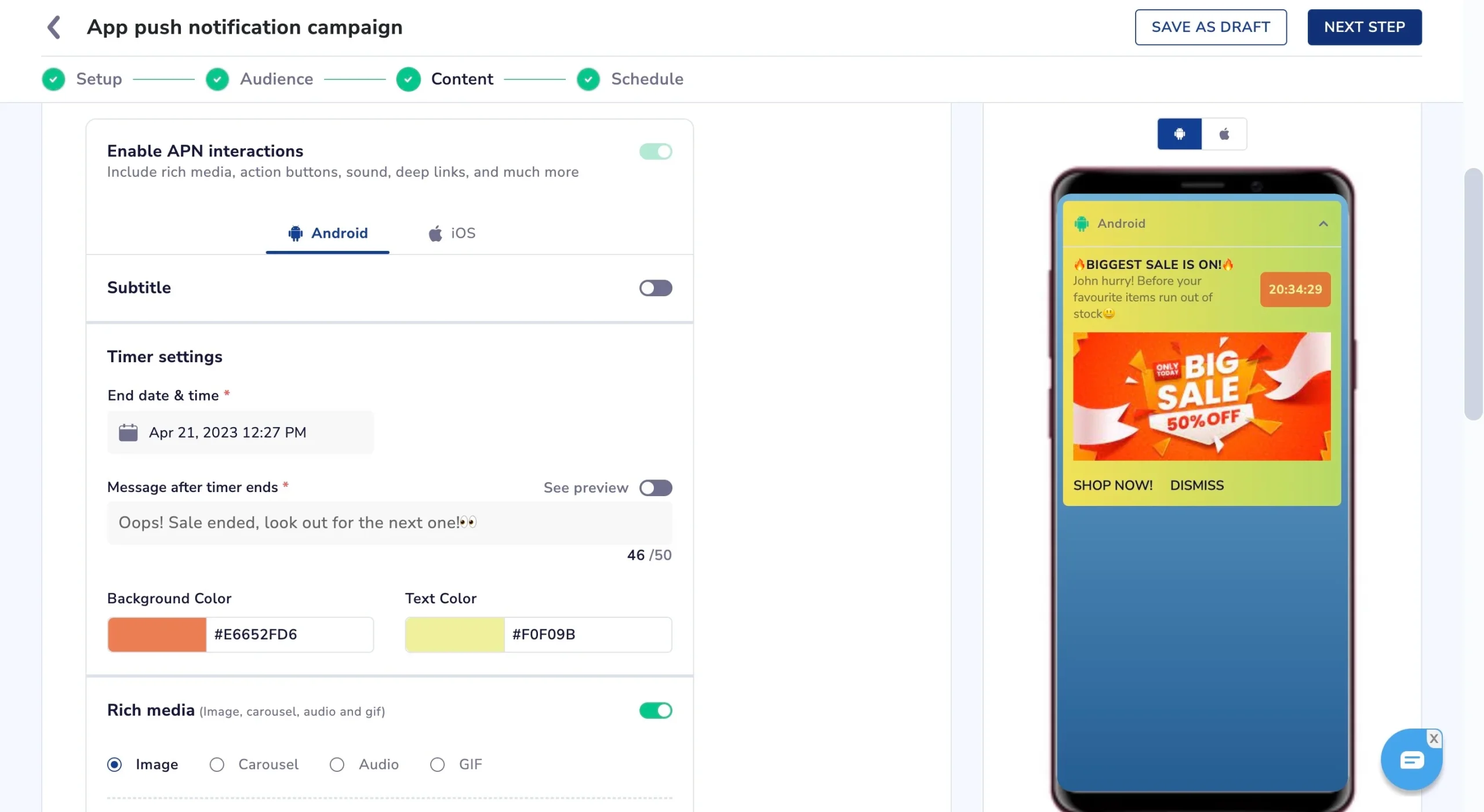
If you’re looking to choose the right marketing automation software for your business, there are several factors to consider.
To help you in the selection process, here are some best practices to follow:
1. Identify your business needs and goals, including the key challenges you want to address and the specific marketing tasks you wish to automate.
2. Consider the scalability and flexibility of the software. Will it be able to handle your business’s growth and increasing demands? If you’re a small business or a startup, you’ll need marketing automation software that’s suitable for small businesses.
3. Assess the feature set of the marketing automation software, including lead generation and capture, email marketing automation, customer segmentation, behavior tracking, cart abandonment recovery, A/B testing, CRM integration, and analytics/reporting capabilities.
4. Ensure that the software seamlessly integrates with your existing tools and systems, such as your CRM platform, eCommerce platform, email service provider, and other essential tools.
5. Consider the user-friendliness of the software and the learning curve associated with it. Look for a solution that offers comprehensive documentation, training resources, and responsive customer support.
6. Evaluate the pricing plans and subscription models offered by the marketing automation software providers. Balance cost-effectiveness and the required features for your business’s growth.
7. Research the reputation and track record of the marketing automation software provider. Look for a provider with a strong support system, responsive customer service, and an active user community.
8. Take advantage of free trials or demos offered by marketing automation software providers to assess its usability, features, and suitability for your business before committing.
Get the Best Results with Netcore’s Push Notification Engagement Platform
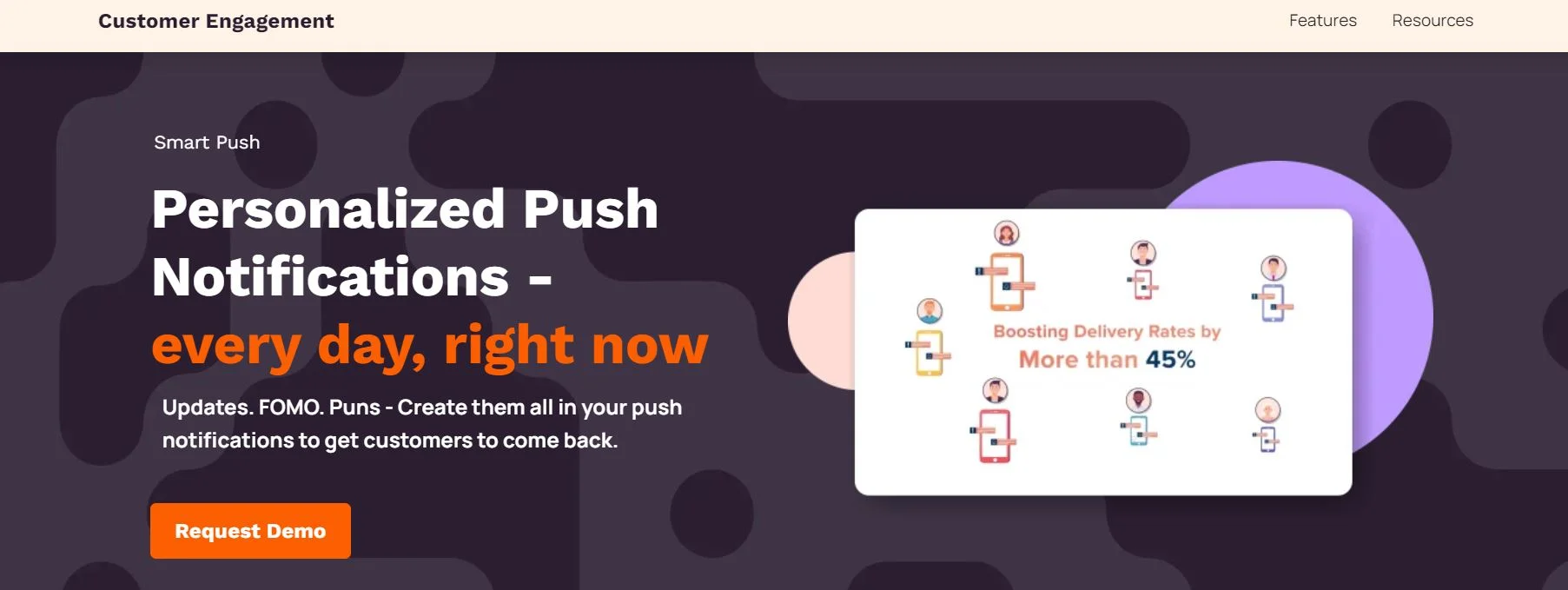
Netcore is a leading marketing technology company that offers a comprehensive platform designed to empower businesses, including eCommerce companies, with intelligent and personalized customer engagement solutions. With a focus on delivering exceptional customer experiences, Netcore’s platform enables eCommerce businesses to optimize their marketing efforts, increase customer retention, and drive revenue growth.
Benefits of Netcore Platform for eCommerce Businesses
1. Advanced Push Notifications:
Netcore’s platform offers advanced push notification capabilities, allowing eCommerce businesses to deliver real-time and targeted messages to their customers.
These push notifications are delivered directly to users’ devices, ensuring instant engagement and creating a sense of urgency that prompts immediate action.
2. Personalized Content:
With Netcore’s robust segmentation features, eCommerce businesses can segment their customer base based on various criteria such as user behavior, preferences, and purchase history.
This enables businesses to deliver tailor-made content and offers to specific user groups, resulting in enhanced personalization and relevance.
3. Triggered Campaigns:
Netcore’s platform enables the creation of triggered campaigns, which automate push notification delivery based on user interactions and behaviors.
Businesses can set up triggers for various actions, such as abandoned cart reminders, welcome messages for new users, or personalized recommendations based on past purchases.
4. Increased Engagement:
The personalized and real-time nature of Netcore’s push notifications leads to increased customer engagement. By delivering time-sensitive offers, limited-time promotions, and personalized product recommendations, businesses can capture customers’ attention and drive immediate action.
5. AI-Powered Intelligence:
Netcore leverages AI algorithms to enhance the intelligence of push notifications. Through AI-driven insights, businesses can deliver highly personalized content, product recommendations, and offers for each individual customer, creating a more engaging and relevant experience.
6. Seamless Integration:
Netcore’s platform is designed to seamlessly integrate with existing eCommerce platforms, making the implementation process smooth and hassle-free for businesses. This ensures a quick and efficient setup, allowing businesses to start engaging customers through push notifications without significant disruptions.
7. Scalable Architecture:
Netcore’s platform is built with scalability in mind, capable of handling large volumes of push notifications without compromising performance. Whether businesses have a small customer base or a vast user network, the platform can efficiently manage push notification delivery.
8. Data-Driven Insights:
Netcore provides comprehensive analytics and reporting tools, enabling businesses to track the performance of their push notification campaigns. With data-driven insights on click-through rates, conversions, and user engagement, businesses can continuously optimize their push notification strategies for better results.
9. Enhanced Customer Loyalty:
Through personalized and engaging push notifications, businesses can foster long-term customer loyalty. By delivering relevant and timely content, businesses can create positive experiences for customers, leading to increased brand loyalty and repeat purchases.
10. Revenue Growth:
Netcore’s platform empowers businesses to drive conversions and revenue growth through effective push notification strategies. By leveraging real-time engagement and personalized content, businesses can maximize customer interactions and increase their chances of converting leads into customers.
Conclusion
Push notification platforms have emerged as indispensable tools for eCommerce businesses seeking to engage customers effectively and boost revenue. By adopting these platforms, businesses can harness the power of real-time, personalized communication to deliver timely offers, product recommendations, and updates directly to their customers’ devices.
The ability to segment users, leverage AI-powered intelligence, and integrate multiple channels further enhances the impact of push notifications, leading to increased customer loyalty and conversions. As eCommerce companies strive to stay ahead in a competitive digital landscape, partnering with a leading platform like Netcore can make all the difference.
To witness firsthand how Netcore’s advanced mobile push notification solutions can elevate your eCommerce business, book a demo today and embark on a journey of unparalleled customer engagement and success.








